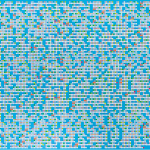

Josh Rowell British , b. 1990
Hercules and the Golden Apples of the Hesperides, 2021
Acrylic on Canvas
102 x 166 cm
40 1/8 x 65 3/8 in
40 1/8 x 65 3/8 in
Josh Rowell has recently been working on a number of paintings within the ‘Painting Language’ series that aim to look back through pivotal moments from art history, seeking to provide...
Josh Rowell has recently been working on a number of paintings within the ‘Painting Language’ series that aim to look back through pivotal moments from art history, seeking to provide some form of evolution to these artistic legacies within the 21st century, contemporary art space. The 12 Labours of Hercules are amongst the most famous stories to emerge from Greek mythology and, crucially for Rowell, they have each been depicted by leading artists throughout the centuries such as Rubens and Goya, amongst others. The Golden Apple of the Hesperides is Hercules’ 11th labour and Rowell has taken a direct translation from Apollodorus’ Bibliotheca, which is a 1st or 2nd century compendium of the early Greek myths and legends.
As a Language Painting, the resulting piece is both a ‘response to’, and an ‘interpretation of’ the artistic legacy that exists around ‘The Labours of Hercules’. As Goya or Rubens were inspired to paint the story in styles pertaining to their oeuvre, period and genre, so too is Rowell now inspired to paint it through the eyes of an artist living in the 21st century. Rowell seeks to create a further ‘re-telling’ of this (and other) artistic legacies, perhaps providing the next step in their art-historical evolution; whilst remaining inspired by a world that has become so heavily dominated by technological expansion. Rowell wants this painting to both reflect on the past, whilst simultaneously comment on the contemporary.
As a Language Painting, the resulting piece is both a ‘response to’, and an ‘interpretation of’ the artistic legacy that exists around ‘The Labours of Hercules’. As Goya or Rubens were inspired to paint the story in styles pertaining to their oeuvre, period and genre, so too is Rowell now inspired to paint it through the eyes of an artist living in the 21st century. Rowell seeks to create a further ‘re-telling’ of this (and other) artistic legacies, perhaps providing the next step in their art-historical evolution; whilst remaining inspired by a world that has become so heavily dominated by technological expansion. Rowell wants this painting to both reflect on the past, whilst simultaneously comment on the contemporary.


